Tiny Machines
In 1959 the physicist Richard Feynman gave a talk called “There’s Plenty of Room at the Bottom,” on the possibility of microminiaturization. To encourage progress he offered a prize of $1,000 to anyone who could build an operating electric motor that fit into a 1/64th inch cube, and within months, someone had done it.
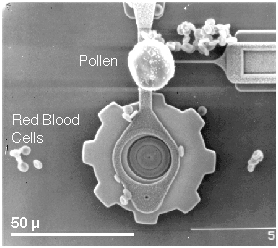
A MEMS crankshaft and gear, with a pollen grain, red blood cells, and a 50 micron line included for scale. Note that this distance is about the diameter of a human hair. (Courtesy Sandia National Laboratories, SUMMiTTM Technologies, www.mems.sandia.gov)
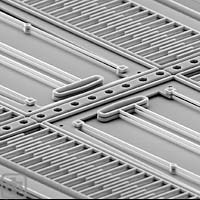
An electrostatic comb drive. The structure in-between the two comb assemblies, in the center of the image, restores the combs to their initial positions when the voltage is turned off. (Courtesy Sandia National Laboratories, SUMMiTTM Technologies, www.mems.sandia.gov)
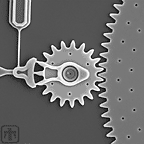
A MEMS drive gear. The shafts extending up and to the left are driven by vibrating motors. (Courtesy Sandia National Laboratories, SUMMiTTM Technologies, www.mems.sandia.gov)
After that, not much happened until the mid-1980s, when physicists and engineers began to apply integrated circuit construction technology—batch processing, lithography, and etching—to produce both the mechanism and the associated electronics out of the same piece of silicon. Thanks to sacrificial layers that are etched away, the gears and rods are fabricated in place and ready to go, with no assembly required. Such devices are known as Micro-Electrical-Mechanical Systems, or simply MEMS. The image shows a MEMS gear and camshaft, with a pollen grain and red blood cells thrown in for scale. This width of this gear is about 50 microns (50 x 10-6 m), roughly a tenth the size of the motor that met Feynman’s challenge. (See Building at the Nanoscale).
MEMS motors are driven by electrostatic forces, so there is no need for winding tiny coils. Two batch-fabricated silicon “combs” form a capacitor, as shown in the diagram. When a voltage is applied to the combs, they attract, with a force that increases with the number and length of teeth in the comb. Mounting the combs on a restoring spring provides a back-and-forth motion as the voltage is switched on and off, and adding a crankshaft enables two combs, mounted at right angles, to spin a wheel, as shown.
MEMS products have been successfully commercialized since the early 1990s, including:
- small, inexpensive accelerometers for automobile air bags
- ink nozzles and reservoirs for inkjet printers
- heads for read-write drives
- arrays of tiltable mirrors for display
The relative size of MEMS-scale forces is quite different from what we experience in the macro-world. For these tiny machines, friction and surface tension are much more important than inertia or weight, since the ratio of surface area to volume varies inversely as the distance and therefore increases with smaller size. For example, for a cube of side s, the ratio of surface area to volume is 6s2/s3 = 6/s. As s decreases, this ratio goes up, making surface effects like friction more significant than inertia or gravity, which both scale with the volume. For the same reason, wear-and-tear from parts rubbing together is correspondingly more important, especially in devices like the comb motor with its back-and-forth movement.
Research
Smaller than MEMS
In 2003, Berkeley physicist Alex Zettl built an electric motor that measures only 500 nanometers across, two orders of magnitude smaller than the electrostatic comb devices. At this scale, conventional MEMS design won’t work, because friction would overwhelm the applied electrostatic forces, so the rotor—a gold plate—is mounted on a shaft of nested carbon nanotubes, with one fastened to the rotor and the others to the silicon base. These nanotubes provide nearly frictionless bearings and also serve as the electrical connection to the rotor. (See Tubular Peas.)
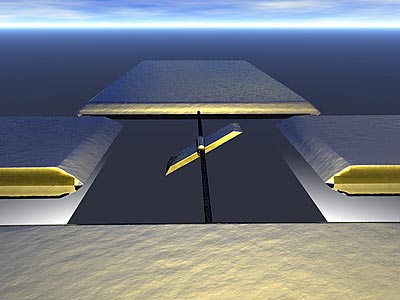
The nanotube motor shaft of the 500 nanometer motor (image courtesy of Zettl research group, UC Berkeley).

The nanotube motor shaft of the 500 nanometer motor (image courtesy of Zettl research group, UC Berkeley).
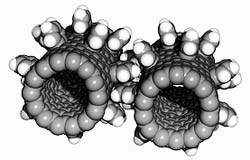
Simulation of motor shaft and gears built up from individual atoms. (image courtesy of NASA).
When time-varying voltages are applied to the rotor and to other stator electrodes around it, the rotor turns. When the voltages are shut off, the rotor stops promptly, since it has little inertia, and stray charges produce electrical forces that quickly bring it to rest. See the movie to view the motor in action.
The scanning electron microscope used to create the image can run only as fast as 30 frames per second (fps), whereas the motor is predicted to spin at hundreds of millions of cycles per second. Consequently, above 30 revolutions per second the researchers currently can’t tell if the motor is actually spinning or only oscillating back and forth, and measuring the top speed of the motor will require improvement in the imaging technology.
Like MEMS devices, the rotor is driven electrostatically and is mounted in a support prepared by masking and etching silicon. But unlike MEMS, which takes advantage of batch processing for low-cost fabrication, Zettl’s motor is a painstakingly assembled proof of concept device, but nevertheless one with possible applications ranging from routing optical signals to carrying out procedures inside cells. For now, the motor enables fundamental studies of nanotube’s electrical and mechanical properties.
Someday, motors may be built up from individual atoms, as simulated in the NASA image of meshing gears. [For the technology of moving individual atoms, visit Seeing Atoms] Also, a brand new technology has emerged that spins a motor by shining light on it, doing away with the wiring and even the bearings. MEMS and NEMS promise all sorts of interesting designs and applications—stay tuned for more.
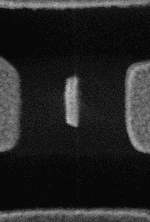
Scanning electron microscope video of the 500 nanometer motor in operation. The nanotube supports are visible. (video courtesy of Zettl research group, UC Berkeley).
Links
CalTech
Sandia National Laboratory
MEMX (a Sandia spinoff)
UC Berkeley
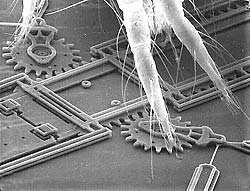
Spider mite dwarfs MEMS gear system. (Courtesy Sandia National Laboratories, SUMMiTTM Technologies, www.mems.sandia.gov)














